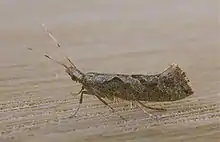Leuroperna sera
Leuroperna sera is a moth of the family Plutellidae first described by Edward Meyrick in 1885.[1] It is found in Japan, Taiwan, Vietnam, Indonesia, India, Sri Lanka,[2] Australia, and New Zealand.[3]
| Leuroperna sera | |
|---|---|
 | |
| Scientific classification | |
| Kingdom: | |
| Phylum: | |
| Class: | |
| Order: | |
| Family: | |
| Genus: | Leuroperna |
| Species: | L. sera |
| Binomial name | |
| Leuroperna sera (Meyrick, 1885) | |
| Synonyms | |
| |
The wingspan of the adult is 10 millimetres (0.39 in).[4] Similar to sympatric moth Plutella xylostella, but can be distinguished by much broader wings and genitalia. The caterpillar is about 10 mm in maximum length. Head with numerous blackish-brown dots. Body green to yellowish tinged with a slender red or pale red dorsal, subdorsal, supraspiracular, subspiracular, and basal lines. Pupa very similar to above mentioned species, but with a pair of hooked setae and maxilla is always shorter than the mid-leg. Pupation is in an open net-like white cocoon on leaf underside. Caterpillars of the two species co-exist in the crop plants.[5]
The caterpillar is known to feed on economically valuable crucifers such as Brassica juncea, Brassica napus, cauliflower, cabbage, Chinese cabbage, radish, turnip and many other wild crucifers.[5]
References
- "Species Details: Plutella sera Meyrick, 1886". Catalogue of Life. Retrieved 29 May 2018.
- Koçak, Ahmet Ömer; Kemal, Muhabbet (20 February 2012). "Preliminary list of the Lepidoptera of Sri Lanka". Cesa News. Centre for Entomological Studies Ankara (79): 1–57 – via Academia.
- Herbison-Evans, Don & Crossley, Stella (9 October 2013). "Leuroperna sera (Meyrick, 1885)". Australian Caterpillars and their Butterflies and Moths. Retrieved 10 October 2018.
- Don Herbison-Evans & Stella Crossley (August 22, 2004). "Leuroperna sera". uts.edu.au. Archived from the original on October 8, 2009. Retrieved February 11, 2009.
- "Taxonomic Notes on the Diamondback Moth" (PDF). Entomological Laboratory, College of Agriculture, University of Osaka. Retrieved 28 March 2018.
External links